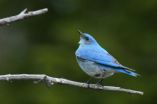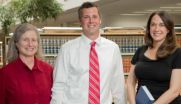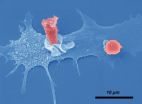(Press-News.org) Although George Church's next book doesn't hit the shelves until Oct. 2, it has already passed an enviable benchmark: 70 billion copies—roughly triple the sum of the top 100 books of all time.
And they fit on your thumbnail.
That's because Church, the Robert Winthrop Professor of Genetics at Harvard Medical School and a founding core faculty member of the Wyss Institute for Biomedical Engineering at Harvard University, and his team encoded the book, Regenesis: How Synthetic Biology Will Reinvent Nature and Ourselves, in DNA, which they then read and copied.
Biology's databank, DNA has long tantalized researchers with its potential as a storage medium: fantastically dense, stable, energy efficient and proven to work over a timespan of some 3.5 billion years. While not the first project to demonstrate the potential of DNA storage, Church's team married next-generation sequencing technology with a novel strategy to encode 1,000 times the largest amount of data previously stored in DNA.
The team reports its results in the Aug. 17 issue of the journal Science.
The researchers used binary code to preserve the text, images and formatting of the book. While the scale is roughly what a 5 ¼-inch floppy disk once held, the density of the bits is nearly off the charts: 5.5 petabits, or 1 million gigabits, per cubic millimeter. "The information density and scale compare favorably with other experimental storage methods from biology and physics," said Sri Kosuri, a senior scientist at the Wyss Institute and senior author on the paper. The team also included Yuan Gao, a former Wyss postdoc who is now an associate professor of biomedical engineering at Johns Hopkins University.
And where some experimental media—like quantum holography—require incredibly cold temperatures and tremendous energy, DNA is stable at room temperature. "You can drop it wherever you want, in the desert or your backyard, and it will be there 400,000 years later," Church said.
Reading and writing in DNA is slower than in other media, however, which makes it better suited for archival storage of massive amounts of data, rather than for quick retrieval or data processing. "Imagine that you had really cheap video recorders everywhere," Church said. "Just paint walls with video recorders. And for the most part they just record and no one ever goes to them. But if something really good or really bad happens you want to go and scrape the wall and see what you got. So something that's molecular is so much more energy efficient and compact that you can consider applications that were impossible before."
About four grams of DNA theoretically could store the digital data humankind creates in one year.
Although other projects have encoded data in the DNA of living bacteria, the Church team used commercial DNA microchips to create standalone DNA. "We purposefully avoided living cells," Church said. "In an organism, your message is a tiny fraction of the whole cell, so there's a lot of wasted space. But more importantly, almost as soon as a DNA goes into a cell, if that DNA doesn't earn its keep, if it isn't evolutionarily advantageous, the cell will start mutating it, and eventually the cell will completely delete it."
In another departure, the team rejected so-called "shotgun sequencing," which reassembles long DNA sequences by identifying overlaps in short strands. Instead, they took their cue from information technology, and encoded the book in 96-bit data blocks, each with a 19-bit address to guide reassembly. Including jpeg images and HTML formatting, the code for the book required 54,898 of these data blocks, each a unique DNA sequence. "We wanted to illustrate how the modern world is really full of zeroes and ones, not As through Zs alone," Kosuri said.
The team discussed including a DNA copy with each print edition of Regenesis. But in the book, Church and his co-author, the science writer Ed Regis, argue for careful supervision of synthetic biology and the policing of its products and tools. Practicing what they preach, the authors decided against a DNA insert—at least until there has been far more discussion of the safety, security and ethics of using DNA this way. "Maybe the next book," Church said.
INFORMATION:
This work was supported by the U.S. Office of Naval Research (N000141010144), Agilent Technologies and the Wyss Institute.
END
NASA's Terra satellite passed over Tropical Storm Gordon as it continues to spin up in the North central Atlantic Ocean, and revealed the storm has become less symmetric, indicating it is being battered by wind shear.
When Terra passed over Gordon on August 16, 2012 at 10:25 a.m. EDT (1425 UTC) the Moderate Resolution Imaging Spectroradiometer (MODIS) instrument captured a visible image of the storm. The image showed that the bulk of Gordon's clouds were pushed to the north and northeast as a result of southwesterly wind shear. The MODIS image showed what appeared to ...
Berkeley — Two new studies by scientists at the University of California, Berkeley, provide a clearer picture of why some species move in response to climate change, and where they go.
One study, published online Monday, Aug. 6, in the journal Global Change Biology, finds that changes in precipitation have been underappreciated as a factor in driving bird species out of their normal range. In the other study, published today (Wednesday, Aug. 15) in the journal Proceedings of the Royal Society B, researchers found a sharp decrease in range for the Belding's ground squirrel, ...
Highlights
Vancomycin was the most commonly prescribed antibiotic in dialysis patients for treating certain bloodstream infections, but cefazolin was 38% better than vancomycin at preventing hospitalizations and deaths from these infections.
Cefazolin was also 48% better at preventing sepsis.
Hundreds of thousands of Americans develop bloodstream infections every year.
Washington, DC (August 16, 2012) — The antibiotic most commonly prescribed to treat bloodstream infections in dialysis patients may not always be the best choice, according to a study appearing ...
Highlights
The blood levels of certain abnormal proteins and the antibodies that attack them rise according to the severity of one of the most common diseases of the kidney.
The findings may help in the diagnosis and management of the disease, called IgA nephropathy.
IgA nephropathy can lead to high blood pressure, swelling and, in some cases, kidney failure.
Washington, DC (August 16, 2012) — Increasing blood levels of particular proteins may act as warning signs for patients with one of the most common diseases of the kidney, according to a study appearing ...
Highlights
Approximately 1 in 40 men and 1 in 60 women of middle age will develop kidney failure if they live into their 90s.
People with reduced kidney function face an even higher risk.
Kidney failure is on the rise and currently afflicts 2 million people worldwide.
Washington, DC (August 16, 2012) — How likely are middle-aged adults to develop kidney failure during their lifetime? A study appearing in an upcoming issue of the Journal of the American Society of Nephrology (JASN) provides some insights, which may be used to help set priorities related to kidney ...
SALT LAKE CITY, Aug. 16, 2012 – A University of Utah survey of judges in 19 states found that if a convicted criminal is a psychopath, judges consider it an aggravating factor in sentencing, but if judges also hear biological explanations for the disorder, they reduce the sentence by about a year on average.
The new study, published in the Aug. 17, 2012, issue of the journal Science, illustrates the "double-edged sword" faced by judges when they are given a "biomechanical" explanation for a criminal's mental disorder:
If a criminal's behavior has a biological basis, ...
What if a key factor ultimately behind a cancer was not a genetic defect but ecological?
Ecologists have long known that when some major change disturbs an environment in some way, ecosystem structure is likely to change dramatically. Further, this shift in interconnected species' diversity, abundances, and relationships can in turn have a transforming effect on health of the whole landscape – causing a rich woodland or grassland to become permanently degraded, for example – as the ecosystem becomes unstable and then breaks down the environment.
For this reason, it ...
High baseline levels of neuronal activity in the best connected parts of the brain may play an important role in the development of Alzheimer's disease. This is the main conclusion of a new study appearing in PLoS Computational Biology from a group at VU University Medical Center in Amsterdam, the Netherlands.
In recent times, it has become clear that brain activity patterns change at an early stage in Alzheimer's disease. Moreover, there is reason to believe that, instead of being the consequence of structural damage, they might be the cause: recently, a direct influence ...
In uncertain environments, organisms not only react to signals, but also use molecular processes to make guesses about the future, according to a study by Markus Arnoldini et al. from ETH Zurich and Eawag, the Swiss Federal Institute of Aquatic Science and Technology. The authors report in PLoS Computational Biology that if environmental signals are unreliable, organisms are expected to evolve the ability to take random decisions about adapting to cope with adverse situations.
Most organisms live in ever-changing environments, and are at times exposed to adverse conditions ...
The cytomegalovirus (CMV) is a member of the herpesvirus family. Although most people carry CMV for life, it hardly ever makes them sick. Researchers from the Helmholtz Centre for Infection Research and from the USA have now unveiled long term consequences of the on-going presence of CMV: Later in life, more and more cells of the immune system concentrate on CMV, and as a result, the response against other viruses is weakened. These research results help to explain why the elderly are often more prone to infectious diseases than young people.
The viral immunologist Professor ...



